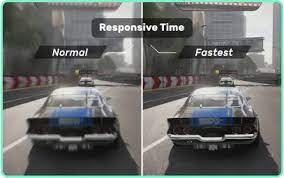In the realm of digital displays, refresh rate plays a crucial role in determining the visual quality of content. It’s like the heartbeat of your screen, dictating how often it updates the image you see. A higher refresh rate translates to smoother, more fluid motion, while a lower rate can result in choppy or jittery visuals.
The Essence of Refresh Rate
Imagine a flipbook. Each page represents a single frame of an animation. The faster you flip through the pages, the smoother the animation appears. This is analogous to refresh rate. A higher refresh rate, like flipping through a flipbook rapidly, creates a seamless, lifelike experience.
Measuring Refresh Rate
Display Settings: Most operating systems provide a straightforward way to check your monitor’s refresh rate. On Windows, right-click the desktop, select “Display Settings,” and scroll down to find the “Refresh rate” option. Similarly, on macOS, click the Apple logo in the top left corner, choose “System Preferences,” then select “Displays” and look for the “Refresh Rate” option.
Online Refresh Rate Testers: Several websites offer online refresh rate test. Simply visit a website like testufo.com or vsynctester.com and run their test. These tests typically display a moving object and ask you to assess its smoothness. A higher refresh rate should result in a sharper, more consistent motion.
Understanding Refresh Rate Terminology
Hertz (Hz): The unit of measurement for refresh rate. One hertz (1 Hz) indicates one refresh per second.
Frame Rate (FPS): The number of frames displayed per second. While refresh rate and frame rate are often used interchangeably, they are distinct concepts. Refresh rate is the hardware limitation of your display, while frame rate is the ability of your graphics card to generate frames.
Tearing: An artifact that occurs when the refresh rate of your monitor and the frame rate of your graphics card are not synchronized. It appears as horizontal lines tearing the image apart.
Real-World Applications of Refresh Rate
Gaming: High refresh rate monitors are highly sought after by gamers, particularly those who play fast-paced first-person shooters. The difference between 60 Hz and 144 Hz, for instance, can be quite noticeable, providing a competitive edge and a more immersive gaming experience.
Video Editing: Video editors often utilize high refresh rate monitors to ensure smooth playback of their work, especially when editing high-frame-rate footage.
General Computer Use: Even for everyday tasks like browsing the web or watching videos, a higher refresh rate can improve overall visual comfort and reduce eye strain.
Conclusion
Refresh rate is a crucial aspect of display technology, significantly impacting the quality of your visual experience. Whether you’re a hardcore gamer, a video editing enthusiast, or simply someone who appreciates smooth visuals, understanding and measuring refresh rate can help you make informed decisions when choosing a display or optimizing your computer’s performance.
FAQ
What is refresh rate?
Refresh rate is the number of times a display updates its image per second. It is measured in hertz (Hz), and a higher refresh rate means that the image will be updated more often, resulting in smoother and more fluid motion.
Why is refresh rate important?
Refresh rate is important because it affects the perceived smoothness of motion on a display. A higher refresh rate can make motion appear more fluid and natural, while a lower refresh rate can make motion appear choppy or jittery. This is especially noticeable in fast-paced action scenes, such as in video games or sports broadcasts.
How do I measure the refresh rate of my display?
There are two main ways to measure the refresh rate of your display:
Check your display settings: Most operating systems provide a way to check the refresh rate of your display. On Windows, right-click on the desktop and select “Display settings”. Scroll down to the “Advanced display settings” section and look for the “Refresh rate” option. On macOS, click the Apple logo in the top left corner and select “System Preferences”. Click on “Displays” and look for the “Refresh Rate” option.
Use an online refresh rate tester: There are several websites that offer online refresh rate testers. Simply visit a website like testufo.com or vsynctester.com and run their test. These tests typically display a moving object and ask you to assess its smoothness. A higher refresh rate should result in a sharper, more consistent motion.
What is a good refresh rate for a gaming monitor?
A good refresh rate for a gaming monitor is 144 Hz or higher. This will provide a smooth and fluid gaming experience, especially in fast-paced action games.
What is the difference between refresh rate and frame rate?
Refresh rate and frame rate are often confused with each other, but they are actually two different things. Refresh rate is the hardware limitation of your display, while frame rate is the ability of your graphics card to generate frames. In other words, refresh rate is the maximum number of frames per second that your display can show, while frame rate is the number of frames per second that your graphics card is actually generating.
What is tearing?
Tearing is an artifact that occurs when the refresh rate of your monitor and the frame rate of your graphics card are not synchronized. It appears as horizontal lines tearing the image apart. Tearing can be very distracting, and it can make it difficult to see what is happening on the screen.
How can I prevent tearing?
There are two main ways to prevent tearing:
Use V-sync: V-sync (vertical synchronization) is a technology that synchronizes the frame rate of your graphics card with the refresh rate of your monitor. This will prevent tearing, but it can also cause input lag.
Use G-sync or FreeSync: G-sync and FreeSync are adaptive synchronization technologies that are similar to V-sync, but they are designed to minimize input lag. They work by dynamically adjusting the refresh rate of your monitor to match the frame rate of your graphics card.
Tips for using Asset Check-In and Check-Out System Efficiently




